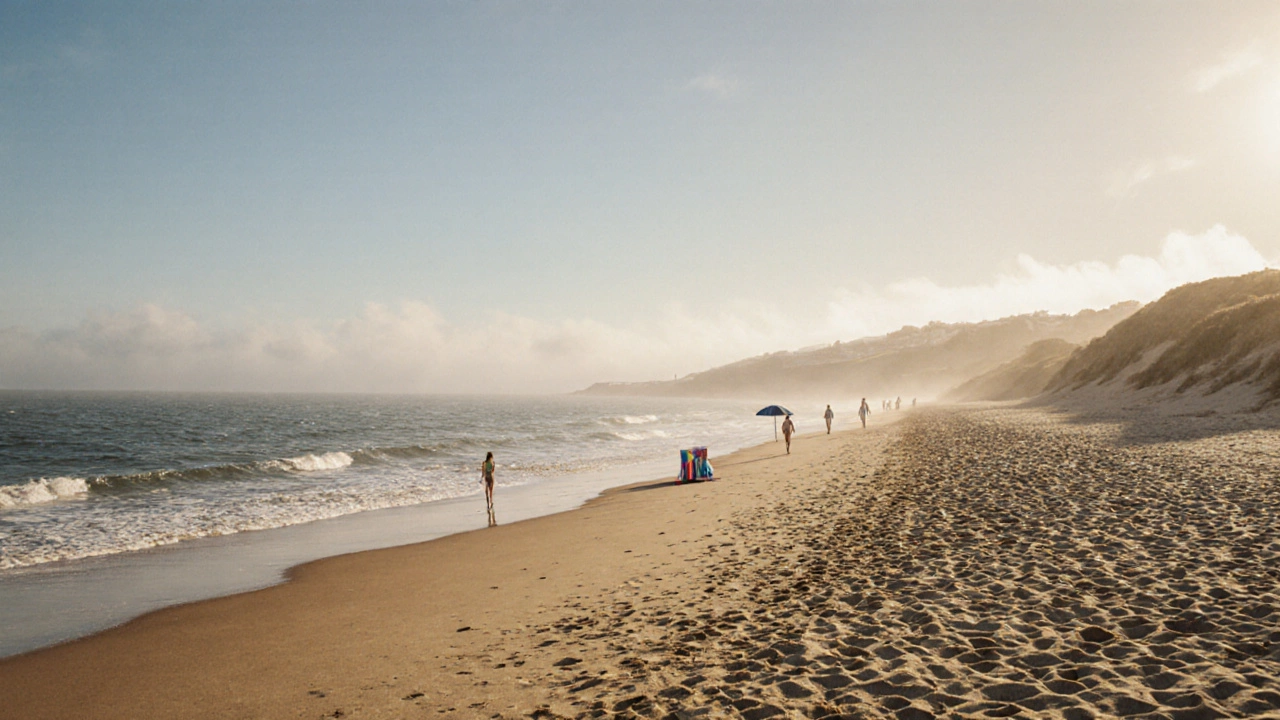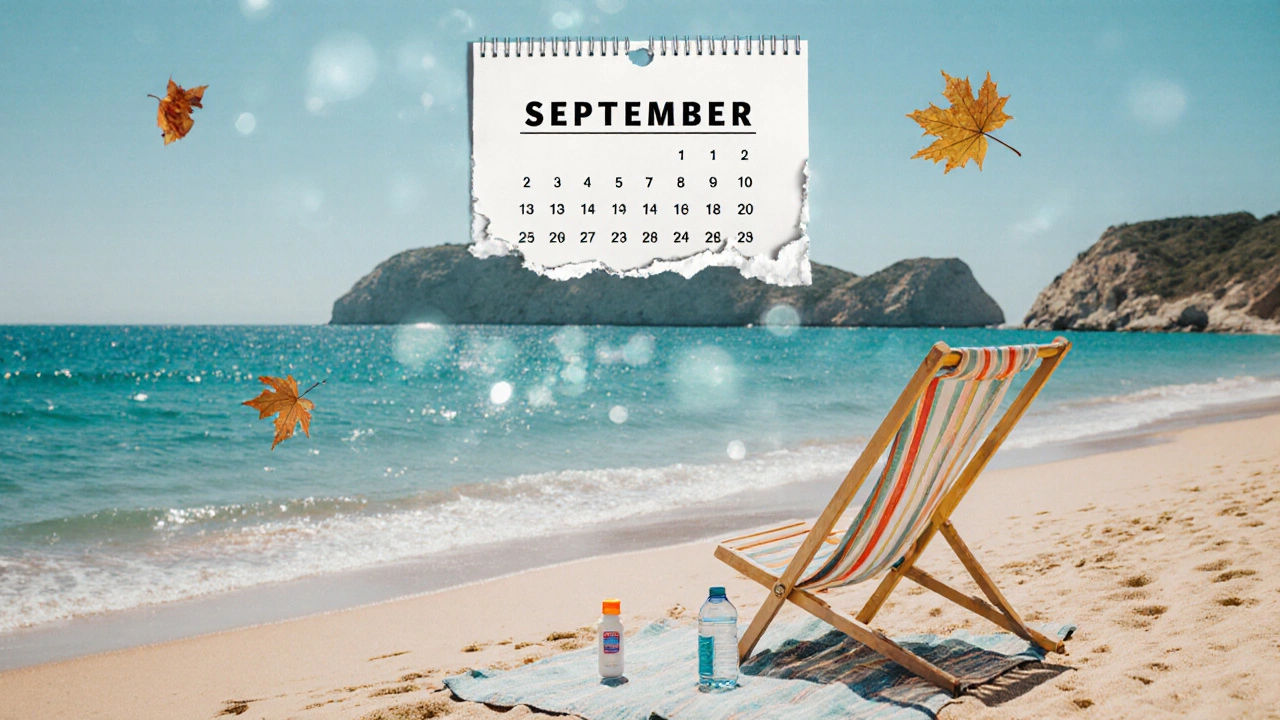Best Month for the Beach: When to Go for Perfect Sun, Sand, and Surf
 Oct, 28 2025
Oct, 28 2025
Beach Month Advisor
Find Your Perfect Beach Month
What to Expect
There’s no magic formula for the perfect beach day-but there is a best month for the beach, and it depends on where you’re going. If you’re chasing warm sand, calm waves, and zero crowds, timing matters more than you think. It’s not just about picking the hottest month. It’s about avoiding storms, overpriced hotels, and jellyfish blooms. The right month turns a vacation into a memory. The wrong one? You’ll be stuck under a beach umbrella, sweating through a $200 hotel bill and wondering why you didn’t just stay home.
It’s Not About Heat-It’s About Comfort
Most people assume July is the best month for the beach. It’s hot, school’s out, and everyone’s posting selfies with coconut drinks. But in many places, July is the worst. Crowds are insane. Prices spike. And humidity? It’s like swimming in soup. The real sweet spot? Shoulder seasons. That’s when the weather’s still great, but the crowds have thinned and the prices have dropped.
In the Mediterranean, late May and early June are golden. The water’s warmed up to 22°C (72°F), the sun’s strong enough to tan without burning, and you won’t fight for a towel spot. Same goes for the U.S. East Coast. June in Florida or North Carolina gives you beach days without the July chaos. By August, the humidity rolls in, the mosquitoes come out, and every hotel room costs $500 a night.
Where You Go Changes Everything
There’s no universal best month for the beach. What works in Bali doesn’t work in Maine. Here’s how to pick the right time for your spot:
- Caribbean: Mid-April to mid-June. Hurricane season starts in June, so aim for before then. April and May have near-perfect temps (28°C/82°F), low rain, and airlines slash prices after spring break.
- California: August and September. The Pacific is cold until late summer. Even in July, water temps hover around 16°C (60°F). By August, the ocean warms up. Surf’s up, crowds are still manageable, and the coastal fog burns off by noon.
- Florida: Late March to early June. Winter crowds are gone, summer storms haven’t hit. The Gulf Coast (Tampa, Clearwater) is especially good in April. Water’s warm, air’s around 26°C (79°F), and you can get a beachfront condo for half the summer price.
- Europe (Spain, Greece, Italy): Late May to early July. June in Santorini or the Amalfi Coast is dreamy. The sun’s out, the sea’s clear, and you’re not elbow-to-elbow with tourists. By August, it’s packed. And the heat? It’s 38°C (100°F) with no breeze.
- Australia: December to February. That’s summer down under. But if you want to avoid the January holiday rush, go in early December. Beaches like Bondi and Byron Bay are lively but not suffocating. Water’s warm, and the UV index? Still brutal-pack sunscreen.
- UK beaches (Cornwall, Devon): July and August. Don’t expect tropical heat. Average highs are 20-22°C (68-72°F). But the days are long, the skies are clear, and the sea’s warmest then. Late August is peak season, so book early. If you want quiet, try late June.
What You’re Really Avoiding
It’s not just about picking the warmest month. It’s about dodging the stuff nobody tells you about.
Storm season hits hard in the tropics. The Atlantic hurricane season runs June to November. Even if you’re not in the direct path, tropical storms bring heavy rain, high winds, and canceled flights. The safest window? April to June in the Caribbean. September to November? Risky.
Jellyfish show up in warm water. In Florida, lion’s mane jellyfish bloom in August. In Australia, box jellyfish are a real danger from October to May. Check local marine reports before you go. Some beaches have warning signs or nets. Others? You just hope you don’t get stung.
Price spikes hit hard in peak months. A $120/night rental in May becomes $350 in July. Flights? Same deal. If you’re budget-conscious, aim for the weeks just before or after peak season. You’ll save 30-50% and still get perfect weather.

The Hidden Gems: Off-Peak Magic
Some of the best beach experiences happen when no one else is there.
In Portugal’s Algarve, October is magic. The summer heat fades, the ocean’s still warm (20°C/68°F), and the beaches are empty. You can rent a villa for the price of a hotel room in July. Same in Tunisia or Croatia. September and October bring calm seas, clear skies, and local restaurants serving fresh seafood without the tourist markup.
In the U.S., September on the Outer Banks of North Carolina is underrated. The air’s still warm, the water’s above 24°C (75°F), and the kids are back in school. You’ll find quiet dunes, no traffic, and sunset picnics with just your partner or your dog.
Even in the UK, late September can surprise you. Cornwall still gets 16-18°C (61-64°F) and 8 hours of sun. The crowds are gone. The cafés aren’t booked solid. And the sea? Still swimmable if you’re tough.
What to Pack-No Matter the Month
Even the best month for the beach can throw you a curveball. Always bring:
- High SPF reef-safe sunscreen (even on cloudy days)
- A wide-brimmed hat and UV-blocking sunglasses
- A light cover-up or sarong for walking to/from the beach
- A quick-dry towel (they’re lighter and dry faster than cotton)
- A reusable water bottle (plastic bottles melt in the heat)
- A small first-aid kit with aloe vera and antiseptic wipes
- A waterproof phone case (because someone’s always dropping theirs)
And if you’re going somewhere with strong tides or currents? Bring a whistle. It’s small, cheap, and could save your life if you get caught in a riptide.

When to Skip the Beach Altogether
Some months? Just don’t go.
In the Caribbean, August and September are a gamble. Hurricanes can cancel your trip last-minute. Airlines don’t refund. Hotels won’t budge. You’ll lose money and time.
In Florida, July and August bring thunderstorms almost daily. You’ll get 20 minutes of sun, then a 45-minute downpour. The humidity sticks to your skin. And the bugs? They’re relentless.
And if you’re in the Northern Hemisphere? Avoid November through March for tropical beaches. The water’s too cold. The days are short. You’ll be shivering under a blanket, wondering why you didn’t pick a ski resort instead.
Final Rule: Pick Your Priority
Ask yourself: What matters most?
- Warm water? Go in late summer (August-September in the U.S., October in Europe).
- Cheap prices? Aim for late spring or early fall.
- Quiet beaches? Avoid school holidays and national public holidays.
- Best weather? Look for months with low humidity and low rain chance.
There’s no perfect month for everyone. But there’s a perfect month for you. Know what you want. Check the forecast. Book early. And skip the July rush. You’ll thank yourself later.
What’s the best month for the beach in Florida?
Late March through early June is ideal. The weather’s warm but not humid, the water’s comfortable, and prices are lower than in summer. Avoid July and August-thunderstorms hit daily, humidity is oppressive, and hotel rates double.
Is June a good month for the beach?
Yes, especially in Europe, the Mediterranean, and the U.S. East Coast. June offers warm temperatures, calm seas, and fewer crowds than July and August. It’s often the sweet spot between shoulder season and peak season.
When should you avoid the beach?
Avoid the beach in hurricane season (June-November in the Atlantic, especially August-September). Also skip November to March in tropical destinations if you want warm water. In places like the UK, winter months mean cold water, short days, and unpredictable weather.
Is September a good month for the beach?
Absolutely. In the U.S., Europe, and Australia, September often has the best weather: warm water, sunny days, and fewer tourists. Prices drop after Labor Day and school starts. It’s one of the most underrated beach months.
What’s the cheapest month to go to the beach?
Late April to early June and September to October. These are shoulder seasons-weather’s still great, but hotels and flights are 30-50% cheaper than in peak summer months. You’ll also avoid the crowds.
